Sure! Here’s a lively, informal, and engaging SEO-style piece focused on the transfer function of an AC servo motor. No overly formal phrasing, no clichés, just a clear flow with some spontaneous touches and thoughtful insights. Here we go:

Ever wondered how an AC servo motor smoothly turns your precision-driven projects into reality? It’s all about the magic happening behind the scenes—specifically, the transfer function that makes everything click. Think of it like the motor’s personal rhythm, a hidden sync that determines how quickly and accurately your system responds to commands.
When you dive into the transfer function of an AC servo motor, what you’re really looking at is its ability to connect input signals—your wishes, basically—with the motor’s actual movements. It’s like a translator that interprets voltage or current inputs into motion across various speeds and loads. Without this understanding, optimizing for precision or speed feels like trying to tune a piano blindfolded.
This transfer function isn’t just some abstract formula tossed around over coffee. It’s a practical tool that tells you how your motor reacts when you tweak the input. For example, if you dial up the frequency, you’d expect the motor to spin faster—but how precisely and steadily? The transfer function provides that feedback. It reveals how different parameters like inertia, damping, and motor resistance play into the response curve.
Now, if you’re questioning how this plays out in real life—say you’re designing a robotic arm or a CNC machine—the transfer function becomes your best friend. It helps you anticipate how the system will behave under various loads and speeds, that unpredictable torque ripple, or sudden changes in resistance. Being able to predict and control this response means fewer surprises and more reliable performance.
You might wonder, “Do all AC servo motors have a similar transfer function?” Well, not exactly. Each model comes with its own quirks—some respond faster, others hold steadier under load. That’s why knowing the transfer function specific to the motor you’re working with isn’t just a detail; it’s a game changer.
Thinking about controlling your motor precisely—that’s where this whole concept shines. When you tune your drive control algorithms based on the transfer function, your system responds more smoothly. No jerks, no overshoot, just that silky motion that every engineer dreams of—whether it’s closing a robotic gripper or aligning a laser beam.
I bet you’ve come across situations where machines jerk unexpectedly or lag behind commands. That’s usually a mismatch somewhere—between what you’re feeding in and how the motor reacts. The transfer function acts like a roadmap to fix that, giving you the insight needed to fine-tune everything.
In short, understanding the transfer function of an AC servo motor is like unlocking a secret code. It’s about grasping the core how and why behind movement and control. Whether you’re optimizing for speed, precision, or reliability, this little piece of engineering knowledge makes a huge difference.
And between us, once you get the hang of this, troubleshooting becomes less frustrating and more like solving a puzzle. You’ll start to see trends and patterns, and that’s when designing smarter systems really takes off. No more guesswork—just clear, confident control over every step of the process.
Established in 2005, Kpower has been dedicated to a professional compact motion unit manufacturer, headquartered in Dongguan, Guangdong Province, China. Leveraging innovations in modular drive technology, Kpower integrates high-performance motors, precision reducers, and multi-protocol control systems to provide efficient and customized smart drive system solutions. Kpower has delivered professional drive system solutions to over 500 enterprise clients globally with products covering various fields such as Smart Home Systems, Automatic Electronics, Robotics, Precision Agriculture, Drones, and Industrial Automation.




































